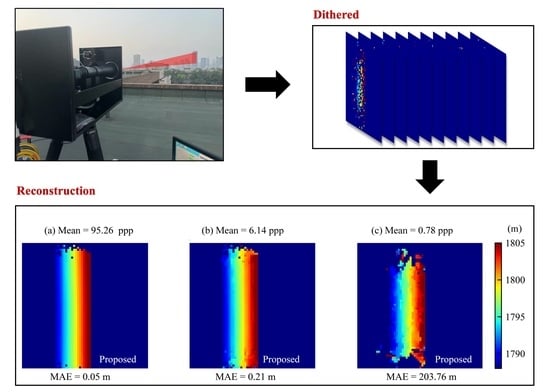Dithered Depth Imaging for Single-Photon Lidar at Kilometer Distances
Abstract
1. Introduction
2. Method
2.1. Data Processing Method
2.1.1. Subtractive Dither Depth Estimation
2.1.2. Censoring of Photon Data
2.1.3. Depth Image Restoration
2.2. Dithered Single-Photon Lidar Measurement Setup
3. Results
4. Discussion
5. Conclusions
Author Contributions
Funding
Data Availability Statement
Conflicts of Interest
References
- Albota, M.; Gurjar, R.; Mangognia, A.; Dumanis, D.; Edwards, B. The Airborne Optical Systems Testbed (AOSTB). In Military Sensing Symp; MIT Lincoln Laboratory Lexington United States: Lexington, MA, USA, 2017. [Google Scholar]
- Clifton, W.E.; Steele, B.; Nelson, G.; Truscott, A.; Itzler, M.; Entwistle, M. Medium altitude airborne geiger-mode mapping lidar system. In Laser Radar Technology and Applications XX; and Atmospheric Propagation XII; SPIE: Bellingham, WA, USA, 2015; p. 9465. [Google Scholar]
- Rapp, J.; Tachella, J.; Altmann, Y.; McLaughlin, S.; Goyal, V.K. Advances in single-photon lidar for autonomous vehicles: Working principles, challenges, and recent advances. IEEE Signal Process. Mag. 2020, 37, 62–71. [Google Scholar] [CrossRef]
- Maccarone, A.; Acconcia, G.; Steinlehner, U.; Labanca, I.; Newborough, D.; Rech, I.; Buller, G. Custom-Technology Single-Photon Avalanche Diode Linear Detector Array for Underwater Depth Imaging. Sensors 2021, 21, 4850. [Google Scholar] [CrossRef] [PubMed]
- Li, Z.-P.; Ye, J.-T.; Huang, X.; Jiang, P.-Y.; Cao, Y.; Hong, Y.; Yu, C.; Zhang, J.; Zhang, Q.; Peng, C.-Z.; et al. Single-photon imaging over 200 km. Optica 2021, 8, 344. [Google Scholar] [CrossRef]
- Shen, G.; Zheng, T.; Li, Z.; Yang, L.; Wu, G. Self-gating single-photon time-of-flight depth imaging with multiple repetition rates. Opt. Lasers Eng. 2021, 151, 106908. [Google Scholar] [CrossRef]
- Shen, G.; Zheng, T.; Li, Z.; Wu, E.; Yang, L.; Tao, Y.; Wang, C.; Wu, G. High-speed airborne single-photon LiDAR with GHz-gated single-photon detector at 1550 nm. Opt. Laser Technol. 2021, 141, 107109. [Google Scholar] [CrossRef]
- Liu, D.; Sun, J.; Gao, S.; Ma, L.; Jiang, P.; Guo, S.; Zhou, X. Single-parameter estimation construction algorithm for Gm-APD ladar imaging through fog. Opt. Commun. 2020, 482, 126558. [Google Scholar] [CrossRef]
- Xu, W.; Zhen, S.; Xiong, H.; Zhao, B.; Liu, Z.; Zhang, Y.; Ke, Z.; Zhang, B. Design of 128 × 32 GM-APD array ROIC with multi-echo detection for single photon 3D LiDAR. Proc. SPIE 2021, 11763, 117634A. [Google Scholar]
- Padmanabhan, P.; Zhang, C.; Cazzaniga, M.; Efe, B.; Ximenes, A.R.; Lee, M.-J.; Charbon, E. 7.4 A 256 × 128 3D-Stacked (45 nm) SPAD FLASH LiDAR with 7-Level Coincidence Detection and Progressive Gating for 100 m Range and 10klux Background Light. Proc. IEEE Int. Solid-State Circuits Conf. 2021, 64, 111–113. [Google Scholar]
- Mizuno, T.; Ikeda, H.; Makino, K.; Tamura, Y.; Suzuki, Y.; Baba, T.; Adachi, S.; Hashi, T.; Mita, M.; Mimasu, Y.; et al. Geiger-mode three-dimensional image sensor for eye-safe flash LIDAR. IEICE Electron. Express 2020, 17, 20200152. [Google Scholar] [CrossRef]
- Jahromi, S.S.; Jansson, J.-P.; Keränen, P.; Avrutin, E.A.; Ryvkin, B.S.; Kostamovaara, J.T. Solid-state block-based pulsed laser illuminator for single-photon avalanche diode detection-based time-of-flight 3D range imaging. Opt. Eng. 2021, 60, 054105. [Google Scholar] [CrossRef]
- Henriksson, M.; Allard, L.; Jonsson, P. Panoramic single-photon counting 3D lidar. Proc. SPIE 2018, 10796, 1079606. [Google Scholar]
- Raghuram, A.; Pediredla, A.; Narasimhan, S.G.; Gkioulekas, I.; Veeraraghavan, A. STORM: Super-resolving Transients by OveRsampled Measurements. Proc. IEEE Int. Conf. Comput. Photog. 2019, 44–54. [Google Scholar] [CrossRef]
- Wu, J.; Qian, Z.; Zhao, Y.; Yu, X.; Zheng, L.; Sun, W. 64 × 64 GM-APD array-based readout integrated circuit for 3D imaging applications. Sci. China Inf. Sci. 2019, 62, 62407. [Google Scholar] [CrossRef]
- Tan, C.; Kong, W.; Huang, G.; Hou, J.; Jia, S.; Chen, T.; Shu, R. Design and Demonstration of a Novel Long-Range Photon-Counting 3D Imaging LiDAR with 32 × 32 Transceivers. Remote Sens. 2022, 14, 2851. [Google Scholar] [CrossRef]
- Yuan, P.; Sudharsanan, R.; Bai, X.; Boisvert, J.; McDonald, P.; Labios, E.; Morris, B.; Nicholson, J.P.; Stuart, G.M.; Danny, H.; et al. Geiger-mode ladar cameras. Proc. SPIE 2011, 8037, 803712. [Google Scholar]
- Pawlikowska, A.M.; Halimi, A.; Lamb, R.A.; Buller, G.S. Single-photon three-dimensional imaging at up to 10 kilometers range. Opt. Express 2017, 25, 11919–11931. [Google Scholar] [CrossRef]
- Li, Z.-P.; Huang, X.; Cao, Y.; Wang, B.; Li, Y.-H.; Jin, W.; Yu, C.; Zhang, J.; Zhang, Q.; Peng, C.-Z.; et al. Single-photon computational 3D imaging at 45 km. Photonics Res. 2020, 8, 1532. [Google Scholar] [CrossRef]
- Chen, Z.; Fan, R.; Li, X.; Dong, Z.; Zhou, Z.; Ye, G.; Chen, D. Accuracy improvement of imaging lidar based on time-correlated single-photon counting using three laser beams. Opt. Commun. 2018, 429, 175–179. [Google Scholar] [CrossRef]
- Rapp, J.; Dawson, R.M.A.; Goyal, V.K. Dither-Enhanced Lidar. In Applications of Lasers for Sensing and Free Space Communications; Optica Publishing Group: Hong Kong, China, 2018; p. JW4A-38. [Google Scholar]
- Rapp, J.; Dawson, R.M.A.; Goyal, V.K. Improving Lidar Depth Resolution with Dither. Proc. IEEE Int. Conf. Image Process. 2018, 1553–1557. [Google Scholar] [CrossRef]
- Rapp, J.; Dawson, R.M.A.; Goyal, V.K. Estimation From Quantized Gaussian Measurements: When and How to Use Dither. IEEE Trans. Signal Process. 2019, 67, 3424–3438. [Google Scholar] [CrossRef]
- Rapp, J.; Dawson, R.M.A.; Goyal, V.K. Dithered Depth Imaging. Opt. Express 2020, 28, 35143–35157. [Google Scholar] [CrossRef] [PubMed]
- Yan, K.; Lifei, L.; Xuejie, D.; Tongyi, Z.; Dongjian, L.; Wei, Z. Photon-limited depth and reflectivity imaging with sparsity regularization. Opt. Commun. 2017, 392, 25–30. [Google Scholar] [CrossRef]
- Altmann, Y.; Ren, X.; McCarthy, A.; Buller, G.S.; McLaughlin, S. Lidar Waveform-Based Analysis of Depth Images Constructed Using Sparse Single-Photon Data. IEEE Trans. Image Process. 2016, 25, 1935–1946. [Google Scholar] [CrossRef] [PubMed]
- Tachella, J.; Altmann, Y.; Marquez, M.; Arguello-Fuentes, H.; Tourneret, J.-Y.; McLaughlin, S. Bayesian 3D Reconstruction of Subsampled Multispectral Single-Photon Lidar Signals. IEEE Trans. Comput. Imaging 2019, 6, 208–220. [Google Scholar] [CrossRef]
- Kirmani, A.; Venkatraman, D.; Shin, D.; Colaço, A.; Wong, F.N.C.; Shapiro, J.H.; Goyal, V.K. First-Photon Imaging. Science 2014, 343, 58–61. [Google Scholar] [CrossRef]
- Shin, D.; Xu, F.; Venkatraman, D.; Lussana, R.; Villa, F.; Zappa, F.; Goyal, V.K.; Wong, F.N.C.; Shapiro, J.H. Photon-efficient imaging with a single-photon camera. Nat. Commun. 2016, 7, 12046. [Google Scholar] [CrossRef]
- Shin, D.; Shapiro, J.H.; Goyal, V.K. Single-Photon Depth Imaging Using a Union-of-Subspaces Model. IEEE Signal Process. Lett. 2015, 22, 2254–2258. [Google Scholar] [CrossRef]
- Harmany, Z.T.; Marcia, R.F.; Willett, R.M. This is SPIRAL-TAP: Sparse Poisson Intensity Reconstruction ALgorithms—Theory and Practice. IEEE Trans. Image Process. 2011, 21, 1084–1096. [Google Scholar] [CrossRef]
- Huang, P.; He, W.; Gu, G.; Chen, Q. Depth imaging denoising of photon-counting lidar. Appl. Opt. 2019, 58, 4390–4394. [Google Scholar] [CrossRef]
- Umasuthan, M.; Wallace, A.; Massa, J.; Buller, G.; Walker, A. Processing time-correlated single photon counting data to acquire range images. IEE Proc. Vis. Image Signal Process. 1998, 145, 237–243. [Google Scholar] [CrossRef]
- Kang, Y.; Li, L.; Li, D.; Liu, D.; Zhang, T.; Zhao, W. Performance analysis of different pixel-wise processing methods for depth imaging with single photon detection data. J. Mod. Opt. 2019, 66, 976–985. [Google Scholar] [CrossRef]

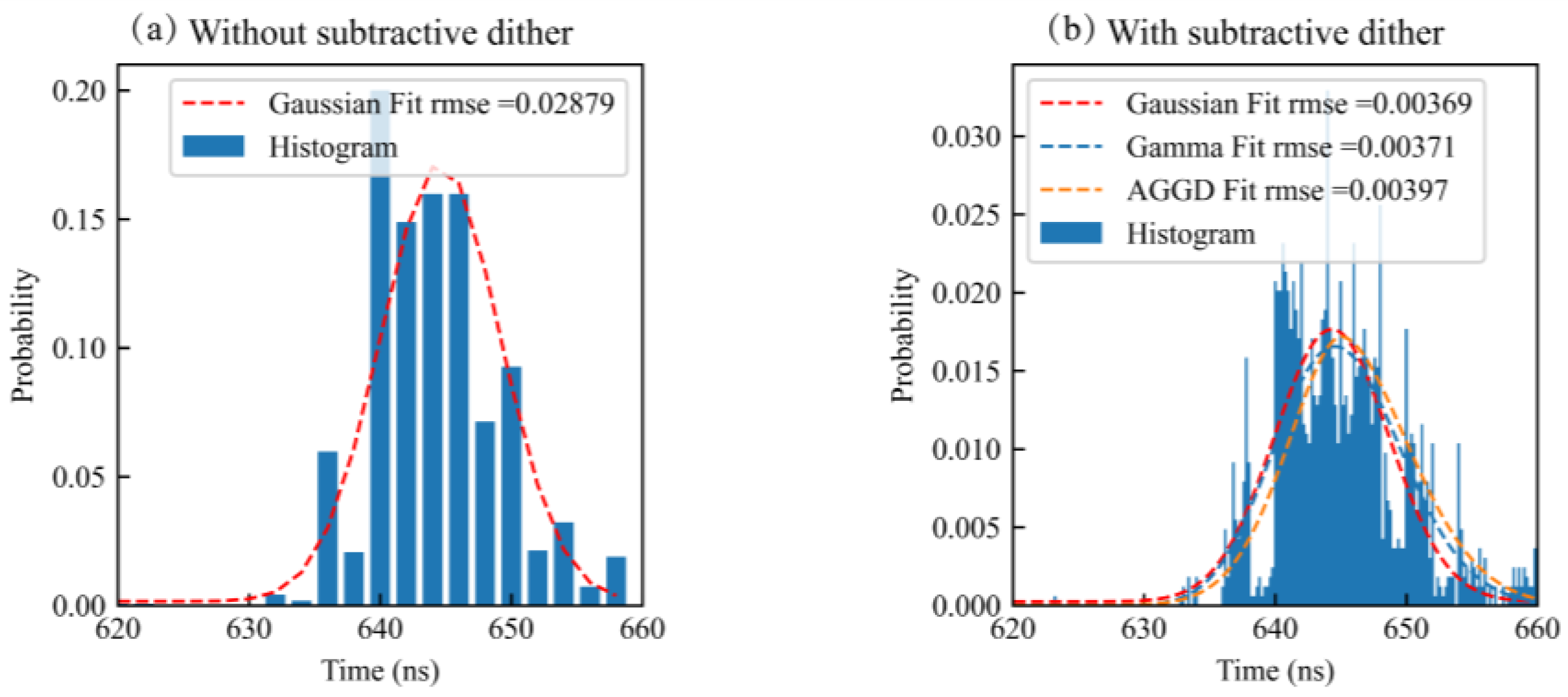
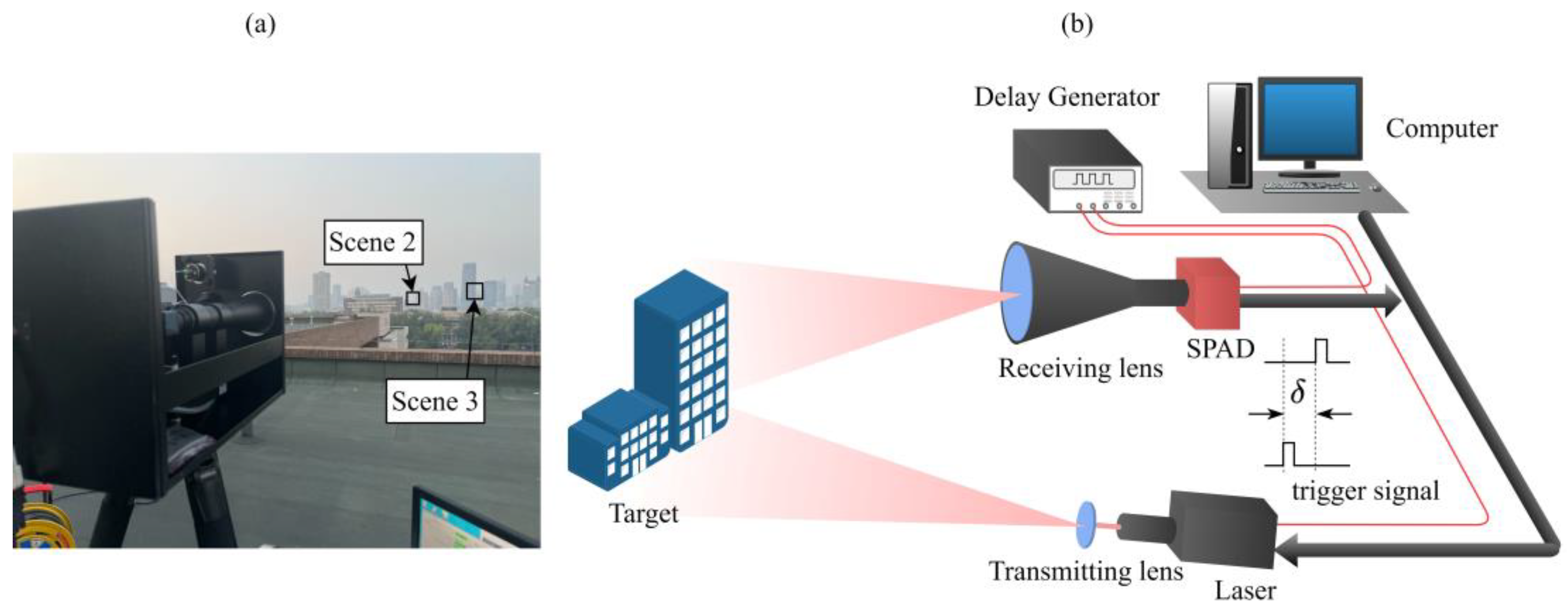
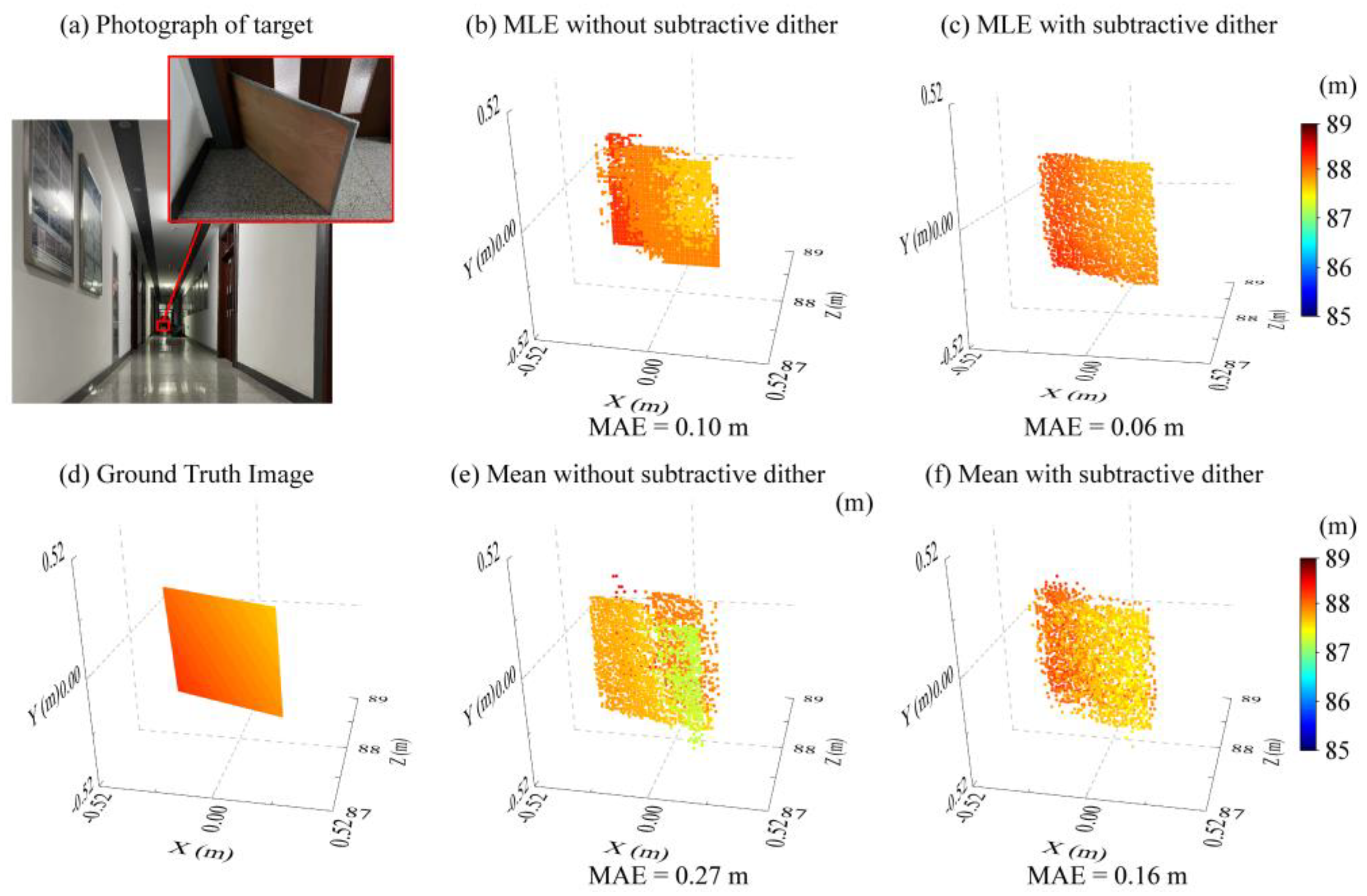
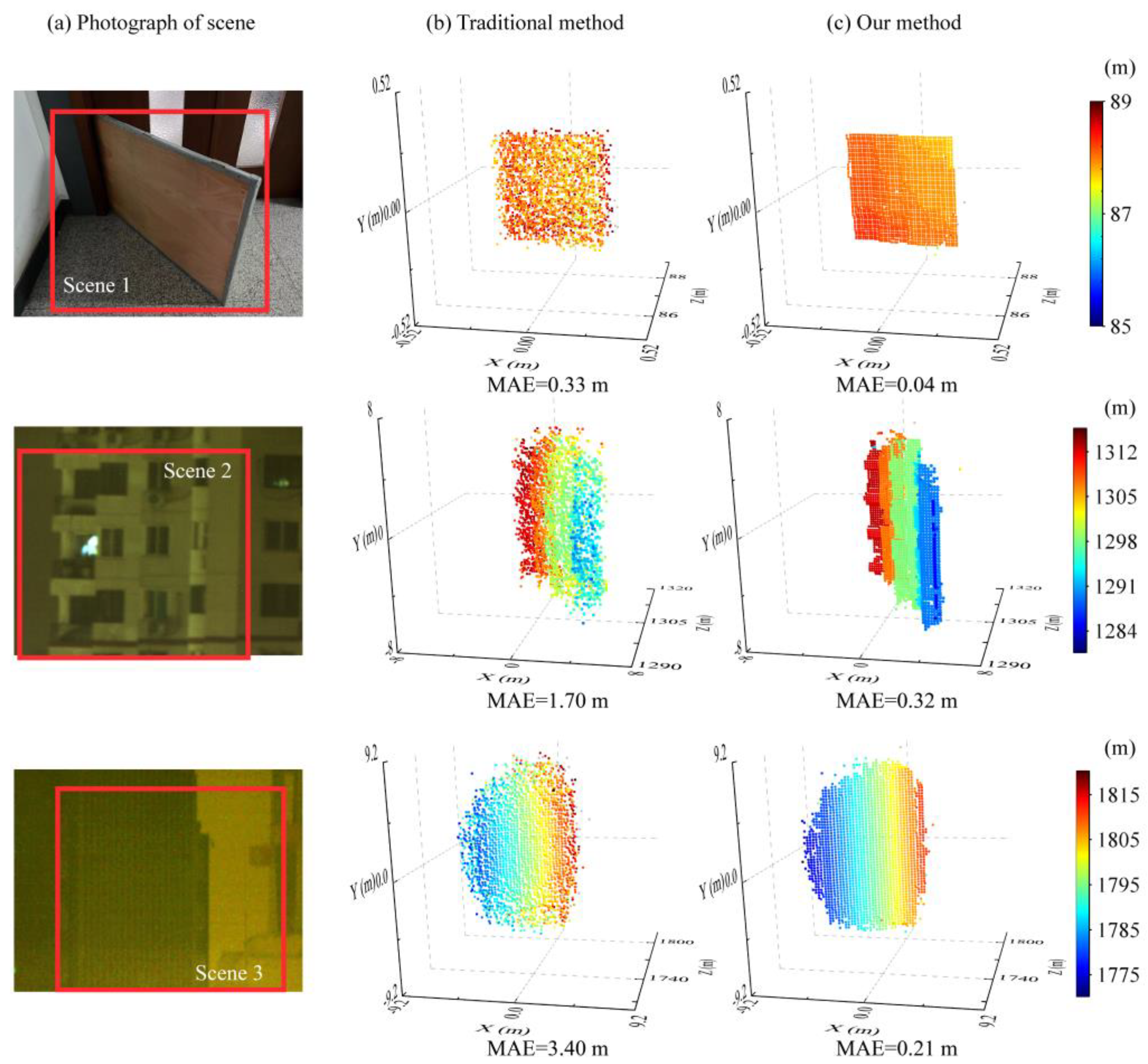


| MAE (m) | |||||
|---|---|---|---|---|---|
| without Subtractive Dither | with Subtractive Dither | ||||
| Scene | MLE | Mean | TV Regularized MLE | RSPE without TV | RSPE |
| scene 1 | 0.33 | 0.35 | 0.16 | 0.21 | 0.04 |
| scene 2 | 1.70 | 1.70 | 1.66 | 0.38 | 0.32 |
| scene 3 | 3.40 | 3.40 | 3.39 | 0.26 | 0.21 |
Publisher’s Note: MDPI stays neutral with regard to jurisdictional claims in published maps and institutional affiliations. |
© 2022 by the authors. Licensee MDPI, Basel, Switzerland. This article is an open access article distributed under the terms and conditions of the Creative Commons Attribution (CC BY) license (https://creativecommons.org/licenses/by/4.0/).
Share and Cite
Chang, J.; Li, J.; Chen, K.; Liu, S.; Wang, Y.; Zhong, K.; Xu, D.; Yao, J. Dithered Depth Imaging for Single-Photon Lidar at Kilometer Distances. Remote Sens. 2022, 14, 5304. https://doi.org/10.3390/rs14215304
Chang J, Li J, Chen K, Liu S, Wang Y, Zhong K, Xu D, Yao J. Dithered Depth Imaging for Single-Photon Lidar at Kilometer Distances. Remote Sensing. 2022; 14(21):5304. https://doi.org/10.3390/rs14215304
Chicago/Turabian StyleChang, Jiying, Jining Li, Kai Chen, Shuai Liu, Yuye Wang, Kai Zhong, Degang Xu, and Jianquan Yao. 2022. "Dithered Depth Imaging for Single-Photon Lidar at Kilometer Distances" Remote Sensing 14, no. 21: 5304. https://doi.org/10.3390/rs14215304
APA StyleChang, J., Li, J., Chen, K., Liu, S., Wang, Y., Zhong, K., Xu, D., & Yao, J. (2022). Dithered Depth Imaging for Single-Photon Lidar at Kilometer Distances. Remote Sensing, 14(21), 5304. https://doi.org/10.3390/rs14215304









